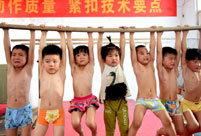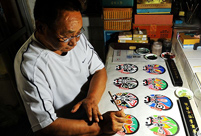 Happy life in Xinjiang
Happy life in Xinjiang
 2014 China Hainan Int'l Automotive Exhibition kicks off
2014 China Hainan Int'l Automotive Exhibition kicks off
 Collection of 'China Dream' public-spirited ads
Collection of 'China Dream' public-spirited ads
 The silent holy stones
The silent holy stones
 University students take care of giant pandas
University students take care of giant pandas
 Leading lady a true legend
Leading lady a true legend
 China Pan-Asia Stone Expo held in Kunming
China Pan-Asia Stone Expo held in Kunming
 Taiwan woman marries into Kazak family, 100 sheep plus a flat as dowry
Taiwan woman marries into Kazak family, 100 sheep plus a flat as dowry
 College girls take graduation photos under water in Chongqing
College girls take graduation photos under water in Chongqing
 Cartoon: Xi and football
Cartoon: Xi and football
China also now has one of the world's highest rates of contraception use in the world. According to figures from the United Nations, the prevalence rate among women who are currently married or in union is about 85 percent, whereas Japan only has a 54 percent rate.
Faced with these encouraging figures, condom makers and retailers are also stepping up their presence in second- and third-tier cities to boost sales.
Shao Yufei, a 35-year-old sex shop owner in Yantai, Shandong province, said: "I thought people in South China, where China's opening-up started, should have a large demand for condoms. But I was wrong. The business was just bad."
Shao also ran a shop in Beijing in 2007, but due to bleak business and fierce competition, he opened another one in Guangzhou and ran it for only six months. He has instead found Yantai, a city with a population of 7 million, ideal for his business.
Shao sells about 300 yuan($48) of condoms a day. Most of them are of the more-expensive foreign brands such as Durex and Jissbon. In Beijing, his daily sales were about 100 yuan.
Duan Tao, deputy director from the medical committee of the China Sexology Association, said: "Condom use is related to a combination of factors including people's awareness of contraception and personal incomes. The awareness of contraception there is no less than that in big cities.
"They also earn more now and are willing to spend more on condoms,"he said.
Thinness vs safety
More Chinese use condoms not just for contraception and the prevention of sexually transmitted diseases and AIDS, but also to improve the quality of their sex life.
"Interestingly, the Chinese emphasize more on the thinness of the condom, while Westerners view safety as a primary concern," said Lin Xiaokang, a sociology professor at Renmin University of China.
In February, Chinese manufacturer Guangzhou Daming United Rubber Products said that it had developed a condom with a thickness of only 0.036 mm, and the product was recognized by the Guinness World Records as the world's thinnest condom.
The previous world record was held by Japanese brand Okamoto, which prides itself on the 0.038 mm series.
Studies show that in real life, many people are still reluctant to use condoms due to various reasons, even as they admit that the devices are the most effective tool to prevent unwanted pregnancies and the spread of AIDS and STDs.
A Bill &Melinda Gates Foundation study found that many men are still "feeling bad about it".
Some people said it is like taking a bath while wearing a raincoat. Others cite the use of condoms as still not user friendly. Some said that when they stop to wear a condom, they can experience erectile dysfunction afterward.
In Guangzhou, a research team last month received funding from the Gates Foundation for the "Grand Challenges Explorations" program that aims to make condoms thinner than 0.3 mm.
Zuo Lian, the project manager of the team, said she hopes in the next year, researchers will succeed in creating condoms with a thickness of between 0.025 mm and 0.03 mm, and most importantly, produce them at an affordable price for the general public.
There is essentially a conflict between thickness and durability in making condoms, Zuo said, and finding a "middle point" is crucial.
"If the thickness of a condom can be reduced to lower than 0.03 mm, the human body will not feel it exists. In medical terms, it is called foreign body sensation. It will revolutionize the sex experience," she said.
With more women using female condoms, they are also expected to have more say in choosing contraceptive methods in a healthy and effective way.
Zhang Yun, project manager of the Program for Appropriate Technology in Health, said that in many Western countries, female condom awareness is on the rise.
But the devices are still considered a new thing in China.
Some people are not used to women condoms, and some worry about its inconvenience of use that make partners feel uneasy.
Efforts are being made to promote it among young women because they might be more likely to accept new things.
According to the World Health Organization, since 1993, there have been about 300 million female condoms distributed in more than 120 countries.
In developing countries, female condom use has increased from 14 million in 2005 to 50 million in 2010. But the female condom market share is still small, accounting for less than 0.2 percent of the global condom market.
 |
 Children attend gymnastics training in summer
Children attend gymnastics training in summer
 Beautiful sceneries along the special travel route in Xinjiang
Beautiful sceneries along the special travel route in Xinjiang
 Germany beat Argentina 1-0 to win World Cup
Germany beat Argentina 1-0 to win World Cup
 Collection of 'China Dream' public-spirited ads
Collection of 'China Dream' public-spirited ads  Chinese Navy frogmen in training: photos
Chinese Navy frogmen in training: photos Hong Kong Fashion Festival kicks off
Hong Kong Fashion Festival kicks off How Chinese men kill the time when their wives practice square dancing?
How Chinese men kill the time when their wives practice square dancing? Lishui, city of longevity with 186 healthy men above 100 years old
Lishui, city of longevity with 186 healthy men above 100 years old Danish badminton team plays Chinese social media users on Asia tour
Danish badminton team plays Chinese social media users on Asia tour Photos of the Week
(July 6 - July 12)
Photos of the Week
(July 6 - July 12)
 'Super moon' seen in Beijing
'Super moon' seen in Beijing
 Happy life in Xinjiang
Happy life in Xinjiang
 'Finding Nemo' in Seattle Aquarium
'Finding Nemo' in Seattle Aquarium The first female Uyghur students in China's naval academy
The first female Uyghur students in China's naval academy
 Hot weather drives citizens to play mahjong in water
Hot weather drives citizens to play mahjong in waterDay|Week|Month